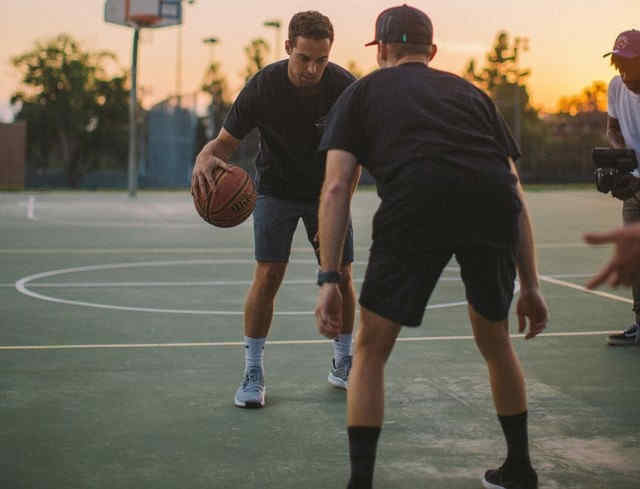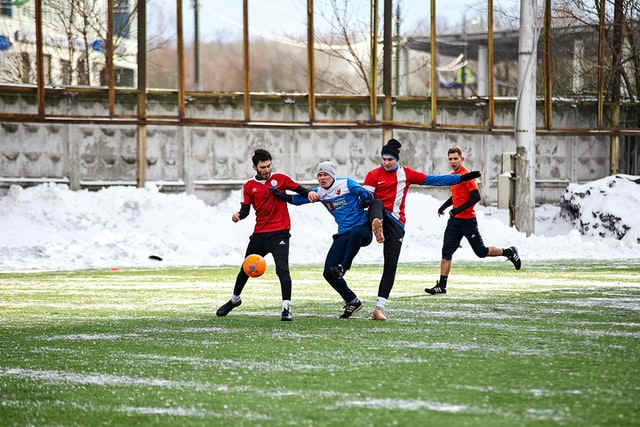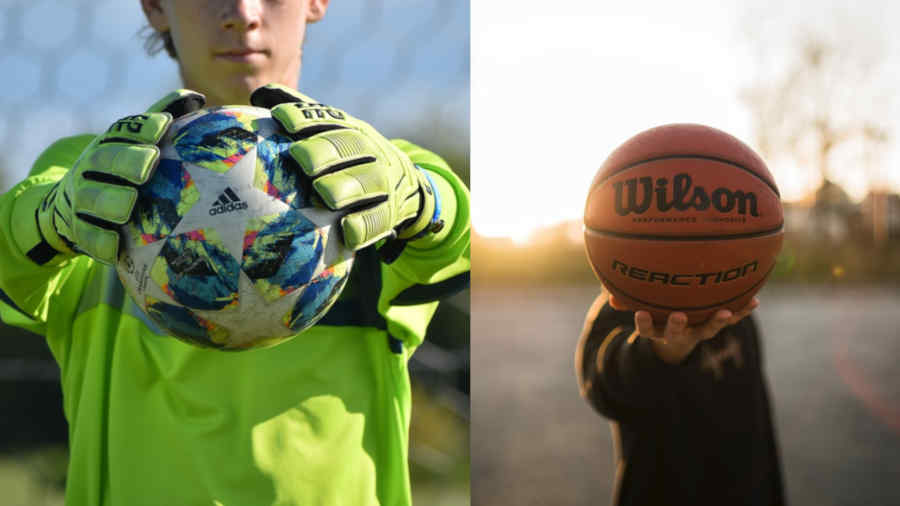Comparing the balls used in different sports can sometimes give you an idea about why the balls are made the way they are for each of these sports.
For example, we talked about the differences between the futsal ball and the soccer ball on this blog before, and we learned the reasons why each of them was made the way it is made.
We’ll do the same thing in this article but with basketball, i.e., we’ll compare the soccer ball to the basketball when it comes to size, bounciness, weight, color and so on.
Without further ado, let’s get started.
1- Basketball size vs soccer ball size
In general, both soccer and basketball experts usually recommend different ball sizes for different ages. However, the basketball is usually bigger than the soccer ball when it comes to size.
Here are the recommended ball sizes per age for both basketball and soccer.
| Age Range | Basketball size (Circumference) | Soccer ball size (Circumference) |
| 12 and above | Size 7 (29.5 inches / 75 cm) | Size 5 (27.5 inches / 70 cm) |
| Between 9 and 12 | Size 6 (28.5 inches / 72 cm) | Size 4 (25.5 inches / 65 cm) |
| 8 or younger | Size 5 (27.5 inches / 70 cm) | Size 3 (23.5 inches / 60 cm) |
As you can tell from the table above, the youngest basketball players (8 or younger) are advised to use a basketball that is equal in size to the soccer ball used by professional soccer players at the age of 12 and above.
In other words, the smallest basketball is equal in size to the biggest soccer ball when it comes to the recommended ball sizes based on age for each of the 2 sports.
Alright, we get it, the basketball is bigger than the soccer ball. But why?
A very logical answer would be that the basketball players will have to grab the ball with their hand and bounce it throughout the whole game. Making the ball bigger will make it easier for them to do so.
The ball will need to be big enough for the basketball players to be able to comfortably do the mentioned actions repeatedly throughout a full basketball game.
As for soccer, the ball needs to be small enough to make sure that the players can control it well with their legs, and large enough to make sure that the goalkeepers can block it easier with their hands.
Hence, the size 5 for soccer is usually the most preferable ball size.
2- Basketball bounciness vs soccer ball bounciness
You might already have guessed that a basketball bounces higher than a soccer ball. However, the difference isn’t really huge.
So to answer the question, the basketball bounces a little bit higher than the soccer ball. Which definitely makes a lot of sense.

In basketball, the ball needs to be bouncy to reduce the amount of force the players have to use while hitting the ball into the ground and getting it up to their hands level again.
The less bouncy the basketball is, the harder it will be for the basketball players to control the ball.
As for soccer, if you increase the bounciness of the ball a lot, then it will be a lot harder for the soccer players to trap the ball correctly when it is moving at a high speed towards them.
In other words, the bounciness of the soccer ball will have to be balanced. You want the ball to be bouncy enough to move it quicker on the field, but not too bouncy to the point that you can’t control it as easily anymore.
And for these reasons, a basketball is usually bouncier than a soccer ball.
3- basketball weight vs soccer ball weight
Without talking too much, here are the numbers:
| Ball Size | Basketball weight | Soccer ball weight |
| 12 and above | 21 oz (595 g) | 14 – 16 oz |
| Between 9 and 12 | 19 oz (539 g) | 12 – 14 oz |
| 8 or younger | 17 oz (482 g) | 11 – 12 oz |
Note that these numbers aren’t 100% accurate for sure, but you can expect the weight of the mentioned balls to be somewhere close to the numbers in the table above.
What the numbers clearly tell you is that a basketball for a certain age range is way heavier than a soccer ball for that same age range.
In fact, the professional soccer ball used in the games between the top tier soccer clubs usually weighs less than the basketball used by the age range of 8 and below.
4- basketball color vs soccer ball color
One of the first things that comes to my mind when someone mentions basketball is the orange color.
Basketballs are usually orange in color. Just google “basketball”, and check the images. The orange color will be the dominant one.
Why orange though? Well, many say that the orange replaced the old brown color simply for visibility.
The basketball used to be brown in color. However, an orange basketball was later tested in an attempt to make the ball more visible to both the players and the audience.
And… the orange ball was pretty impressive when it comes to visibility, and it has been adopted since then by many professional basketball competitions.
Why orange exactly? Well, I have no idea. It’s just one of the colors that are bright enough and have enough contrast in a basketball environment and so it was picked.
Could they pick any other color? Well, definitely yes, as long as the ball is clearly visible to the audience and the players.
As for soccer, the traditional soccer ball is a white and black ball. However, the colors of the soccer ball aren’t limited to white and black anymore.
Most soccer leagues around the world are adopting colorful balls. As long as the colors do not interfere with the color of the grass and other colors on the soccer field, then the colors can be used on the soccer ball.
But what about the orange color? Does the orange color have any significance in soccer when it comes to the balls used?
YES. it does. An orange soccer ball was traditionally used during soccer games that were held in extremely cold weather.
Traditionally, if the snow starts falling, the players use an orange soccer ball to make sure that the ball is more visible during the match on a field full of snow.

Since the field will be covered with snow, a traditional black and white soccer ball will be harder to spot, and thus orange balls are generally used when it starts snowing during a soccer match.
They also paint the markings on the soccer field with an orange color (instead of white) during snow just to make sure that the markings remain visible during the game.
So to sum this whole thing up, a basketball is usually orange in color. As for soccer balls, we are seeing more and more colors being used on the balls replacing the traditional and famous black and white soccer balls.
Before I end this article, there are 2 interesting and quick questions that I would like to discuss here.
Can you use a basketball to play soccer?
Well, yes you can, but will it be a wise decision?
If you have a soccer ball and a basketball, it only makes sense that you use the soccer ball to play soccer.
But what if you don’t have a soccer ball? Will a basketball do? I would say yes.
A basketball is one of the most suitable balls for soccer from a pool of many other types of balls used in different sports.
The basketball is heavy so your kicking muscle memory won’t have a hard time adapting to the basketball.
It’s true that the basketball is bouncier, but it is also heavier than a soccer ball so you might not take a lot of time to adapt to the basketball when it comes to trapping the ball during a soccer game.
However, it is usually a wise decision not to play soccer using a basketball for too long for multiple reasons. One, you might ruin the ball in the long run. Two, you don’t want your muscle memory of kicking an actual soccer ball to fade away over time.
Can you use a soccer ball to play basketball?
Now the other way around. Is it a good idea to use a soccer ball for basketball? No. In my opinion, it is not.
Here are some of the reasons:
1- You will ruin the soccer ball
The soccer ball is designed to be kicked and passed, not to be bounced multiple times every few seconds.
2- The soccer ball is less bouncier than a basketball
You will have to apply a lot more force to keep the soccer ball bouncing than you normally would when bouncing a professional basketball.
This will make you get tired sooner than you might think.
3- The soccer ball weighs less
You will have a very hard time adapting your basketball throwing skills to your “soccer ball throwing skills”.
It will take you time to adapt to the new weight of the ball when it comes to scoring points in a basketball game and so on.
And there are a few other reasons like the ball grip, the ball texture and so on. But I will leave it here.
CONCLUSION
The basketball and the soccer ball have a lot of similarities, but they also have their differences to make sure that each one of them is well suited for the needs of the sport that it belongs to.
We have reached the end of this article, but before you move on, if you would like to check a full comparison between soccer and basketball and not just the balls, you can check this article over here

